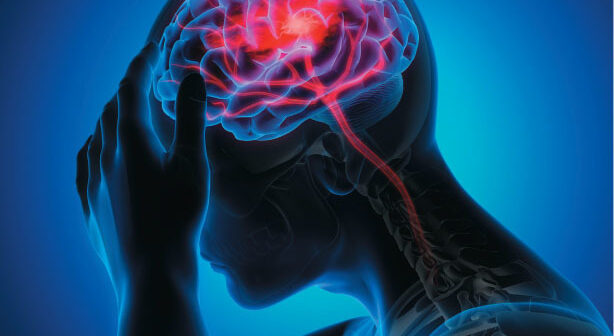For the approximately 20% of American adults who have chronic pain1 – pain you wake up with, go to sleep with, and that won’t go away until you die – appropriate treatment is of paramount interest. The easiest way to confirm that is by fast-forwarding through commercials on television. But finding treatment whose benefits exceed the risks while enabling a quality of life for an individual in pain can prove challenging because the U.S. healthcare model has often ignored the most important tool for managing chronic pain – the brain.
A Bio-Psycho-Social treatment approach, similar to what Harvard MedTech uses in conjunction with virtual reality to deliver relief to people with either acute or chronic pain, leverages the full humanness of the patient. While there are three components in this approach – bio, psych, social – the brain plays a central role in each. As the article title suggests, pain is in the brain. Not that it’s made up by the patient – although pain is highly subjective and therefore can vary dramatically between patients – but the patient’s brain has an inordinate amount of influence on the response to pain and therefore the outcomes. Addressing psychosocial issues is a major key to positive clinical outcomes.
Three areas of the brain are of utmost importance in determining how pain is perceived:
- The thalamus is responsible for directing nerve messages to the appropriate part of the brain for processing while also being responsible for pain perception
- The ventromedial prefrontal cortex processes risk and fear, emotional responses, decision-making and self-control
- The cerebral cortex is where all inputs go to be converted into perceptions (thoughts) but, more importantly, into responding actions
A growing understanding of the brain explains how it is key to managing pain. In fact, pain is not pain until it reaches the brain. The mere presence of noxious stimuli does not define pain – the brain does.
For physical pain, the “bio” (biological) model can be incredibly important for recovery (“to bring back to normal position or condition”2). If the noxious stimuli represent something that cannot heal on its own – for example, a compound fracture – a biological intervention like surgery is required. Other actual or potential damage can be healed by the body with some help from the patient; for example, a sprained ankle that requires RICE (rest, ice, compression, elevation). If the pain involves a disease, like Parkinson’s, then medications are usually a necessary component of the treatment. In the case of fibromyalgia, a condition that leads to widespread pain but often without a specific source, there are likely many interventional procedures used for both treatment and ongoing diagnosis.
In many cases, a Bio-Medical mode3 can properly resolve the pain and help the patient return to normalcy of life. But in other cases – often frustrating to both the clinician and the patient – that primary focus on the body is insufficient.
For example, an over-reliance on prescription painkiller pills (especially opioids) in the U.S. has led to disastrous results, not just in tolerance, addiction and overdose death but in fostering a passive approach to one’s own well-being. Relinquishing locus of control by assuming somebody or something else is going to take care of the problem is one of the most dangerous side effects from a Bio-Medical model. This passivity can enable poor behavior, like solely relying on prescription medications to treat diabetes without losing weight and adopting a more nutritious diet.
In 1977, George Engel proposed a Bio-Psycho-Social treatment approach that takes into account the whole person. “Engel’s model prescribes a fundamentally different path from the still-guiding biomedical model: To be scientific, a model for medicine must include the psychosocial dimensions (personal, emotional, family, community) in addition to the biological aspects (diseases) of all patients.”4 This became “patient-centered” medicine that “puts the patient’s needs foremost (e.g., interests, concerns, questions, ideas, requests) but continues to include disease issues.” This major paradigm shift needed some time to gain a foothold in healthcare, but now most enlightened providers, patients and payers fully understand the value of this approach to pain management and can cite anecdote, statistics and science to confirm its efficacy.
Part of the confirmatory science of a Bio-Psycho-Social model is the natural biological occurrence of neuroplasticity, first mentioned in 1948 by Jerzy Konorski but more widely acknowledged in the 1960s. Simply, neuroplasticity is the constant changing of an individual’s brain to adapt to interactions, stimuli and experiences by creating new neural pathways. Six practices offer the “potential to rewire and retrain your brain to react differently to pain:
- Regular exercise;
- Healthy eating;
- Quitting smoking;
- Keeping your mind active, engaged and challenged;
- Relaxation techniques to keep stress at bay;
- Mindfulness meditation (Irving, 2016).”5
The new neural pathways created constantly by neuroplasticity can either be a positive or negative addition to how someone thinks about – perceives – their pain. If it is negative, then a Bio-Psycho-Social model is the only treatment approach that will help the patient.
These two profound advancements – Bio-Psycho-Social and neuroplasticity – are relatively recent in the history of mankind. But better understanding of how the brain works and how inputs change how the brain works has created a massive evolution in the treatment of pain. This new knowledge opens up acceptance for treatment options beyond pills and procedures to address co-morbidities that increase the intensity and duration of pain.
Every patient brings unique experiences to their pain. These include physical healthiness, adverse childhood experiences, genetic makeup, past and current socioeconomic circumstances, family history of physical and mental health, personal and family history of substance abuse, social determinants of health and many other internal / external influences that make each individual an individual. Every human being encounters trauma at some point, but not everyone is equipped, because of their background, to overcome it. All of this “baggage” can have an indirect impact on the pain based on their level of resilience. The American Psychological Association offers some excellent advice on four core components for establishing resilience – connection, wellness, healthy thinking and meaning – because “as much as resilience involves ‘bouncing back’ from these difficult experiences, it can also involve profound personal growth.”6
Stress, anxiety and depression can often be a by-product of lingering chronic pain and in some cases can actually accentuate the pain. Stress is a natural hyperarousal survival mechanism – in other words, it’s a good thing for an immediate threat – but when it is extended for hours, days, months or years it becomes destructive as it impairs cognition, sleep and social skills. Anxiety can be a companion to stress and creates both physical and psychological symptoms when it becomes unmanaged or long-term and merges into a “self-sustaining feedforward loop.”7 A never-ending cycle of not feeling well can devolve into episodic or clinical depression. But since both pain and depression are influenced by the neurotransmitters serotonin and norepinephrine, a physical injury can actually cause depression based on chemicals and not just emotions. All three of these are emotions (“psych”) that can negatively affect the ability to cope with pain that will possibly never go away and probably get progressively worse. Unfortunately, they all can lead to “social” isolation, which makes matters worse.
When all of these psychosocial considerations are taken into account, it is obvious that actively training (or re-training) the brain toward self-efficacy (“confidence in the ability to exert control over one’s own motivation, behavior, and social environment”8) must be the goal for the effective management of pain. Waiting for somebody or something else to fix it will only exacerbate the psychosocial co-morbidities, leading to a downward spiral in capability and motivation.
Clinicians wanting to go beyond the superficial to address these psychosocial issues in order to achieve optimal clinical outcomes must change how they interact with the patient. Some methods to consider are:
- Focus on active listening in a non-judgmental manner.
- Respect the patient’s expertise in their pain experience.
- Build value and worth by identifying and clearly articulating the patient’s strengths.
- Empower the patient to (re)discover their locus of control.
- Rewrite the dominant narrative by changing negative thought patterns (“I deserve this”) to positive thought patterns (“I am an overcomer”).
- Honestly prepare them for the path ahead so they are not surprised by the inevitable setbacks.
- Utilize tools like Cognitive Behavioral Therapy, Acceptance and Commitment Therapy, Motivational Interviewing, pain coaching, support groups and virtual reality to help rewire their brain and reframe their pain.
- Encourage mindfulness and deep diaphragmatic breathing for self-control.
- Incorporate outcome measures like PROMIS, PHQ and PCS at baseline and over time to not only measure improvements but provide positive affirmation that what’s being done is working (and to make adjustments if it’s not).
- Engage a multidisciplinary approach for complex circumstances – the best programs include a physician, behavioral psychologist and physical therapist but can also include an occupational therapist, nutritionist, yoga instructor, massage therapist, acupuncturist, vocational rehabilitation counselor and other clinical perspectives to help address every aspect of that individual as they build appropriate coping mechanisms.
For many clinicians, a Bio-Psycho-Social approach – such as the one provided by Harvard MedTech’s Vx® Pain Relief Program – requires a much deeper relationship with the patient than their current practice. That might also mean the payer needs to reimburse for a higher level of care. But when provided the opportunity to help someone live a meaningful life in spite of their pain, then the extra effort is worth every penny of that investment. That investment looks even better when compared to the exorbitant costs of treating a patient for opioid addiction or, worse yet, overdose.
In order to fully treat pain, there must be a partnership between the clinician and patient to create a customized management plan. The only way that happens is by having access to every potential evidence-based tool available and then deploy/evolve whatever tactics work for this individual in an empathetic, whole-person (Bio-Psycho-Social) method. But it all starts with understanding and leveraging the most magnificent pain management tool of all – the brain.





